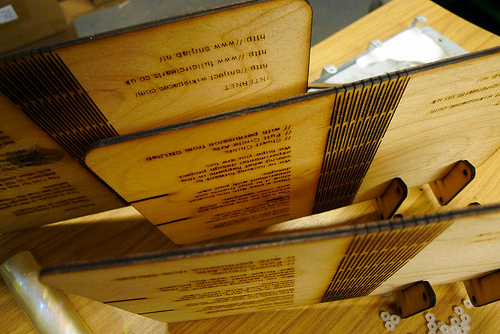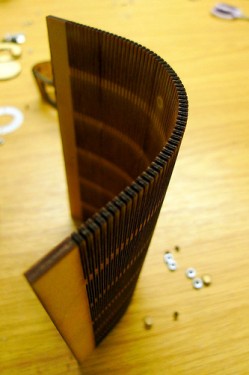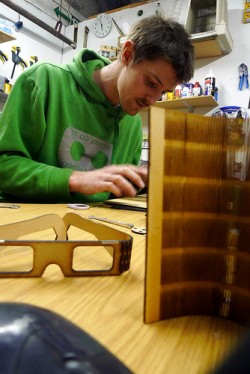
What do you do when there’s a laser cutter in your workshop and you come across a nifty new way of making a hinge on the internet? If you’re Stu Childs you go along to Full Circle Arts and say “look at this cool thing!” and organise a competition to see what people can make with it.
Stuart is one of those chaps who likes to get stuck into things. On a recent visit to his workshop I was treated to the sight of drawbots working away by themselves, assembled friispray cans and piles of parts for them, lamps made from old mobile phone chargers, potatoes with (silicon) chips embedded in them (loved the irony) and a most disreputable looking sofa. And lots and lots of laser-cut components for spectacles, puzzle boxes, tools and strange, unknowable objects. He saw a blog post about this hinge – it came from Snij Labs in Rotterdam – and thought “I could use this”. It took a little while to work out what it could be used for and so to find out what other people could make of it Stu launched SNIJect.
The hinge is pretty simple; it’s a sequence of straight-line cuts in the middle of a piece of MDF, or acrylic, or anything that’ll go through a cutter. The more cuts there are the more flexible the material. Feeling it is quite peculiar, too. The idea that this is, to all intents and purposes, a solid, flat plane of wood that seems to bend without breaking is one that takes some getting used to. In order to demonstrate it Stu put together a notebook cover made from a single lasered piece of wood with a grippy component glued into the inside, and started posting it to people who might be interested. “I really wanted to get people to think about what could be made,” he starts. “This was a way of demonstrating it clearly. People love them.”

The competition came about as Stu was talking to Full Circle in Manchester who offered to sponsor the project, and they put forwards a proposal for Future Everything, the tinkering conference held there in May. The idea is that people can join a wiki, get some files and ideas and then put forwards their own ideas as to what could be made using the hinge. Snij Labs are helping judge the competition – the design is Creative Commons licensed so anybody can use it without paying a license fee – and there are cash prizes available for the best overall design and the best project. Local company Oomlout are also helping out, and have started the ball rolling by refactoring one of the boxes that they sell to use the hinge.
Stu started off with the notebook design but has also been thinking about spectacles. “I based these off a pair of free 3D specs I had in a drawer”, handing some to me. “I’ve got some ideas on how to strengthen the hinge to make them less breakable, like steam treatments, resins, that sort of thing”. I was blown away by the idea; I could see people ordering bespoke glasses by inputting some facial measurements, picking the colour or pattern of the materials. Opticians around the world could be turning out well-fitting frames made from cheap local materials. All it takes is some vector graphics. Boxes, cupholders, cameras, slidey things, protective sleeves, picture frames, iPad cases, watch straps, all sorts of things could be made using this method. And thinking about it, the tools that are created to make the object can sometimes be as nifty as the object itself. That’s the joy of these laser cutter thingies; prototyping is fun.

So do you have an idea that could be turned into something real? It doesn’t even have to be a finished product – in fact, there is an expectation that it won’t be. There’s a prize available for the best process and project, as well as product. The competition closes on May 1st, and any work submitted could be exhibited at Future Everything in May and perhaps even at the Open Knowledge Foundation in Helsinki later on this year. And you could win cash money, too.